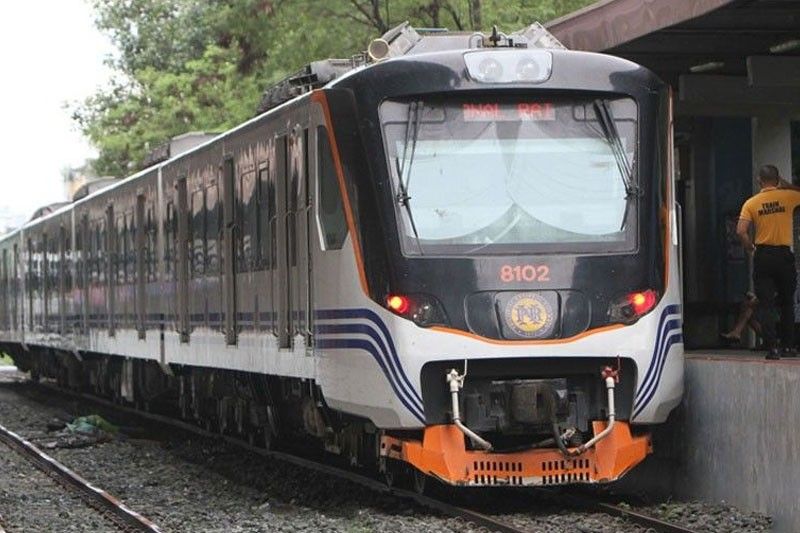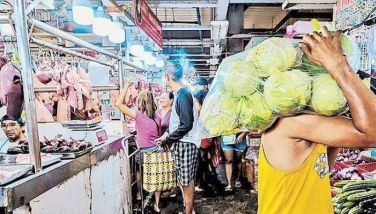For Bicol’s Farm Sector Rural resurgence requires rail revival

SPECIAL REPORT
(First of two parts)
LIBMANAN, Camarines Sur, Philippines — Robert Buayaban grew up hearing and imagining stories of train rides on the fabled Bicol Express in the 1980s, mostly from his grandparents who were farmers.
It’s a story that has been passed on from one generation of Buayabans to another: sacks of rice, vegetables and even pigs loaded onto a train en route to the Philippine capital – Legazpi to Manila; Manila to Legazpi.
Those stories remained stories for someone who never experienced the train ride himself, as he grew up some 170 kilometers away from mainland Bicol.
But since embracing his farming roots, 38-year-old Robert, who was born in Masbate, aspires to see his crops being loaded into a train en route to Laguna or even to Manila in the future.
It would be life-changing, he says.
But just how life changing would it be? Buayaban makes it simple: for every P100 spent on a vegetable, about P30 goes to logistics alone.
It is a significant portion of their costs, which he says could otherwise be used for other important things like for planting materials or for the education of their children.
“Malaking tulong kung magkaka-tren kasi malaking bawas sa gasolina, sa drayber at mababawasan iyong wastage namin,” Buayaban tells The STAR during a visit to his three-hectare farm here.
“Imagine, iyong talong dito sa Bicol ay P72 per kilogram pero sa Maynila ay P100 per kilogram. Ang sitaw dito P20 per kilogram, sa Maynila P70 per kilogram,” he adds.
But farmers who do not have the capacity to transport directly to Manila are forced to rent trucks with a going rate of P4 per kilogram. But that amount – seemingly small – does not take into account the possible losses through pilferage, and wastage that they may incur along the 10 hours to 12 hours of land travel from Bicol to Manila.
Without the proper handling and environment for transporting crops, farmers run the risk of spoiling their goods even before they arrive in Balintawak or in Divisoria, the main trading posts in Metro Manila.
Those losses could spell the difference between making a profit or not.
Bicol and agriculture
Around 70 percent of Bicol’s agricultural output is exported to other areas outside Luzon, most especially in Metro Manila.
Bicol serves as one of the critical suppliers for some vegetables that are sold in the Metro such as red chili, eggplant, squash, stringbeans and other crops that form part of the so-called pinakbet veggies.
At the height of the COVID pandemic in 2020, Bicol was a saving grace for people living in Metro Manila. The province was the source for their daily supply of vegetables and crops, transporting more than 200 metric tons of fruits and vegetables to Metro Manila during the nationwide lockdown.
The growth of the contribution of agriculture, forestry and fishing to Bicol’s economy has been steady at an average rate of five percent annually between 2000 and 2014.
But in the years that followed or from 2014 to 2023, the growth of the sector has been challenged, struggling to sustain the expansion posted in the previous years as it recorded an average dip of 0.4 percent every year.
The contraction in agricultural production and the advancement of other sectors shrank the share of agriculture, forestry and fishing to Bicol’s overall economy.
From a share of 27.5 percent in 2000, agriculture, forestry and fishing is now contributing 14.2 percent to the region’s gross domestic product, the lowest share in the past 24 years.
In recent years, Bicol’s agriculture suffered numerous challenges from extreme weather conditions, including typhoons that battered the region, diseases such as the African swine fever to high production costs and low farm mechanization levels.
Despite contractions in agricultural output, Bicol remains as the top producer of the following crops nationwide: first in abaca, pili nut and squash, second in sweet potato, third in pineapples, fifth in gabi/taro, sixth in string beans, seventh in cassava and eggplant and eight in coconut.
“One way to encourage our farmers to produce more and market their produce is to be given a more efficient logistics system,” says Adelina Losa, chief of the agribusiness and marketing division of the Department of Agriculture - Regional Field Office V.
“Imagine, if the vegetable is sold in Manila at P100 per kilogram, at least P20 of that goes to logistics alone,” Losa adds.
The revival of the train system for cargo would not just benefit some 600,000 farmers in the Bicol region, but its entire population too. Bicol also needs to rely on other regions like up north in Ilocos and Cordillera for its supply of highland vegetables such as lettuce, cabbage, pechay and even onions.
“Farmers are asking when will the train be revived? There is already a route toward Legazpi, so when is the Manila-bound route going to happen?” Losa says.
Opening opportunities
Some 70 kilometers away from Libmanan, Arvin Reola, a corn and vegetable farmer in Iriga, shares his Bicol Express story. For him, a train does not just transport goods, it also transcends markets.
A reliable train system makes farmers more competitive and allows them to earn more as it lets them bring their produce to other markets that offer higher prices for their crops, Arvin says.
For example, corn fetched P18 per kilogram during the last harvest season in Camarines Sur, but the commodity was being bought at P21 per kilogram in nearby provinces.
But since farmers have no means to transport their goods far away, they are left with no choice but to sell within his immediate vicinity, often to the kompradas or traders who can buy bulk but at a much lower price.
In turn, it is the traders who have the capacity to transport goods to bigger buyers like feed millers that earn more.
“Iyong piso, dos, tres, malaking bagay na iyon para sa aming magsasaka. Pahabaan talaga ito ng pisi para may pantawid-tawid kami,” says the 28-year-old farmer who cultivates corn, vegetables and rears livestock in Iriga, Camarines Sur.
“The train system opens opportunities for local farmers to have choices if they will sell their produce locally or to other regions. It stimulates competition,” Reola adds.
He recalled that one time they envied the prevailing live weight prices for hogs in Batangas. Back then, Batangas prices were P20 per kilogram higher than the prices in Bicol, which meant that 10 pigs would fetch P20,000 more if sold in Batangas.
“We can already pay our laborers and buy other farming inputs with that money,” he says.
Imagined future
The revival of the railway in Bicol for cargo has long been on the table of the government.
In fact, it has been identified as one of the critical projects that would contribute to the overall economic growth of the region under the Marcos administration’s economic blueprint.
The government is talking to multilateral agencies for possible loans to finance the P175-billion rebuilding of the Bicol Express through the Philippine National Railways South Long Haul, which was originally pitched to the government of China.
Rep. Brian Yamsuan of Bicol Saro Party-list has been pushing for the revival of the Bicol Express line to fast-track the economic development in the region.
He has even floated the idea of using the Maharlika fund, the nation’s first sovereign wealth fund, to usher in what he calls the “renaissance” of the Bicol Express.
Yamsuan emphasizes that it is not only Bicolanos that would benefit from such an infrastructure program but the entire Luzon as it would reduce food prices within the island region.
“Lower logistics costs would translate into higher incomes for farmers and traders, and would lower food prices for consumers,” he says.
But as these plans remain on paper, farmers like Arvin and Robert focus on the tangibles: improving productivity at all costs. Robert plans to create a fishpond in his farm, thanks to a solar powered irrigation system from the government that allowed him to have ample water resources.
“Sana sa susunod na mga taon, itong mga talong ay sa tren na isasakay,” says Buayaban, who now cultivates at least 10,000 trees of eggplants.
To be concluded
- Latest
- Trending




























